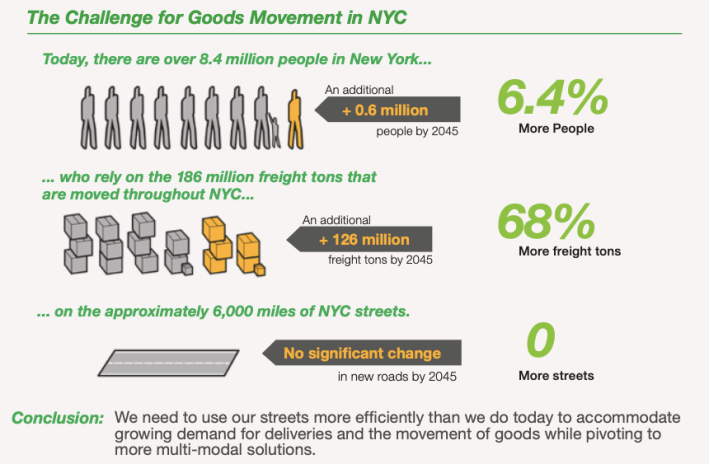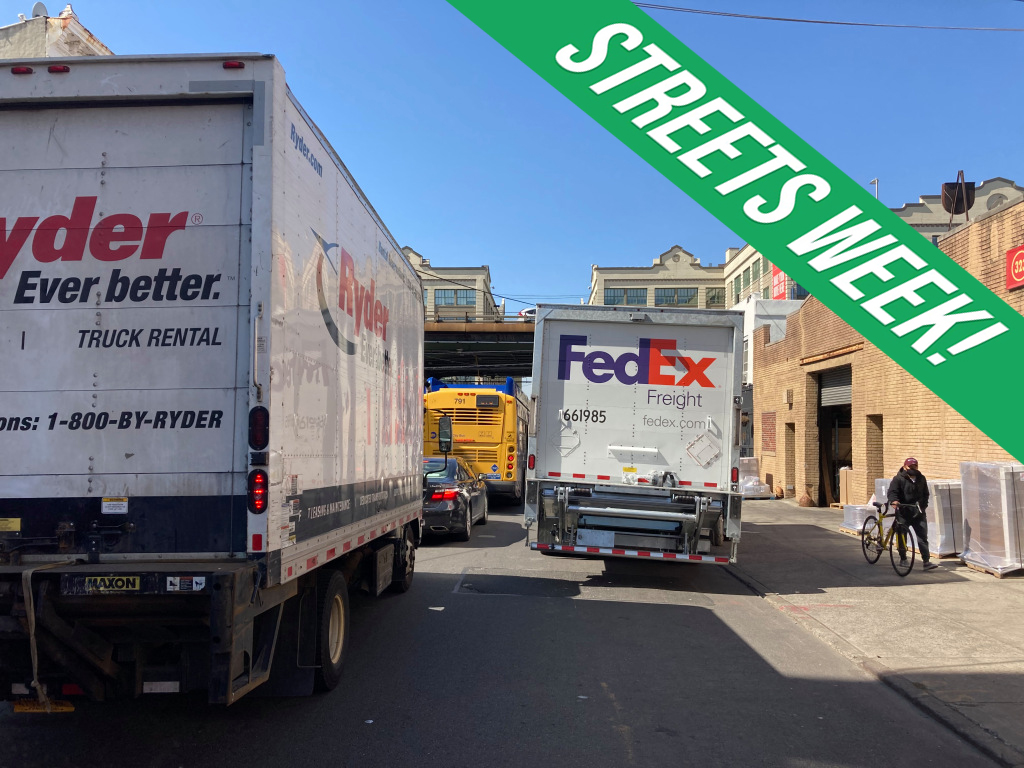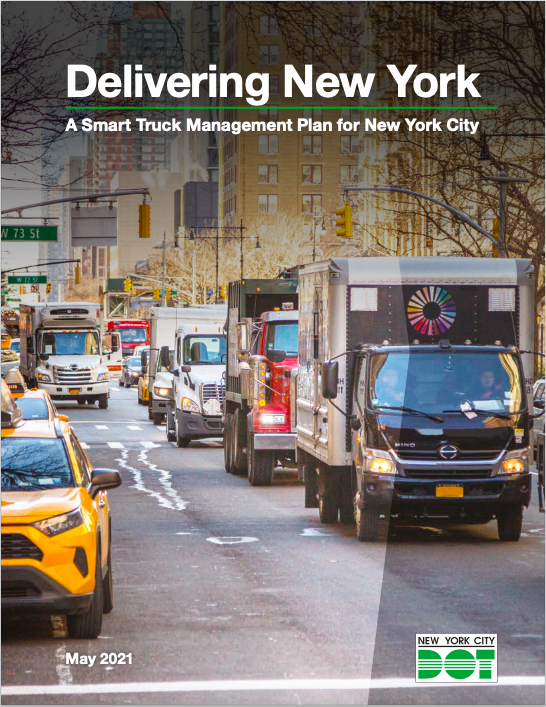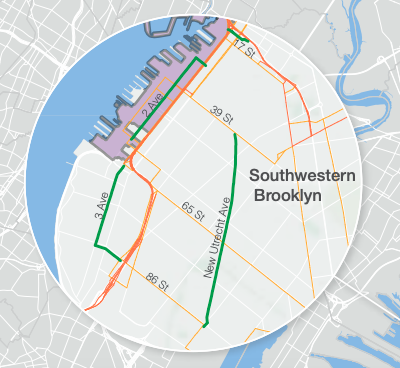The Department of Transportation says it has a plan to mitigate congestion and reduce the number of crashes on city streets caused by the commercial trucks that deliver 90 percent of our goods, but the 104-page proposal falls short of actual details needed to solve the problem, advocates say.
The new report, “Delivering New York: A Smart Truck Management Plan for New York City” (released on Thursday, Day Four of the mayor’s Streets Week!), is heavy on fascinating details about the simply massive system that delivers everything from everywhere to every location, thanks, mostly to 120,000 trucks entering or leaving the five boroughs every day. The report even explains how a banana gets from Central or South America to your door. It's a good read.
But the report offered few hard details on how the city intends to actually improve the streetscape. Words like "encourage" (or "encouraging"), "promote," "support" and other phrases such as "the city must do..." suggest city action, but those terms vastly outnumber words of actual action, such as "the city will..." or "the city has..."
That said, the report is "a step in this direction," said Kate Slevin of the Regional Plan Association.
"The New York metro region must have a comprehensive plan for goods movement in order to continue reducing emissions and repurposing street space," she said. "The plan has great components — like encouraging more cargo bikes for last mile deliveries and increasing the number of truck loading zones – but how effective it ultimately is will be determined by the details of the implementation process."
Outlining the problem
The report is strongest when it's discussing the extent of today's problem.
Currently, the trucking industry — which includes big rigs like tractor trailers, delivery trucks, dump trucks, utility trucks, and tow trucks — delivers nearly 90 percent of the city's goods on those 120,000-plus trucks daily. That number is expected to grow by up to 75,000 by 2045 if nothing is done.
The report revealed that simply e-commerce deliveries inside New York City increased to 500 million in 2018, up 13 percent from just one year (!) prior. That number will go up 100 percent to 1 billion e-commerce package deliveries by 2024 at the current growth rate.
"Overall, traffic volumes [in New York City] have grown by 12 percent between 2015-2018," the report says, "but truck traffic volumes have grown by 21 percent."
Do the math:

New York, you may have noticed, is built on water — yet 8 percent of goods are floated here. And just 3 percent arrive by rail — and the result is a burden on the city's already-clogged streets and crumbling infrastructure such as the Brooklyn-Queens Expressway.
Other infrastructure is also up to the challenge of today's trucking industry needs: The report revealed that truckers smashed into low-overhead bridges 429 times between 2013 and 2018.
"Fifty-one percent occurred on just 10 corridors citywide,” the report said.
Contrary to most people's gut reaction, trucks are not a huge safety hazard, given their numbers.
DOT said that between 2003 and 2016, trucks were involved in just 6 percent, or 55,134, of all non-highway crashes, and accounted for 5 percent, or 2,407, of non-highway crashes that resulted in serious or fatal injuries. (That said, the report did not point out that 2019 was a particularly bloody year for truck victims, with 15 people killed, including 30-year-old Em Samolewicz, who was run over by the driver of a tractor-trailer on Third Avenue in Sunset Park; and 28-year-old Devra Freelander, who was killed by the driver of a cement truck on Boerum Street in Bushwick.)
Congestion and bad roads cost the trucking industry millions of dollars each year — in 2015, the industry lost 60.7 million hours of productivity in the city due to congestion, equal to nearly $3.9 billion, according to the report.
So clearly there's a problem. And when asked Thursday about the report, which has been in the works for five years, Mayor de Blasio said he agrees that the city needs a fix, though he was vague on specifics.
"This is about getting away from the way we have been doing things. We're going to use more rail. We’re going to use the water more. We’re going to use bike cargo more. We’re going to do things differently," he said. "And we’re going to focus on getting deliveries out of rush hour, into overnights, reduce congestion, reduce pollution. There’s a lot of work to be done. But what’s important here is the city wants to push for all these alternatives and use every tool we have."
Fixing the problem
The de Blasio administration started working on this plan in 2016 with the goal of reducing congestion and creating a cleaner, more sustainable city, in part by relying more on our waterways and rail to move some of the bulk of the city's deliveries.
The plan follows FreightNYC, a trucking scheme launched in 2018 by the city’s Economic Development Corporation. That plan sought to "modernize the city's freight distribution system through strategic investments in maritime and rail infrastructure, as well as the creation of new distribution facilities."
That plan called for relatively small investments and predicted relatively small gains: A $25-million “hub and spoke” marine freight system and a $15-million rail transfer center will reduce truck modal share by about 5 percent, bringing it down to 85 percent.
So where's the beef?
Even at its most concrete, the report does not make clear the agency's plans. One of its specific proposals — a call for “new design standards” to enhance truck safety by 2025 along 70 corridors where pedestrian and cyclist deaths and severe injuries from trucks are most concentrated — offers no details on what those new design standards are, or where they will be implemented first (a DOT spokeswoman later told Streetsblog that "the exact corridors will depend on project outreach and implementation schedules").
The report also confirms why placard abuse is actually a problem — many of the curbside parking spaces and designated loading zones are often occupied by vehicles with placards on their dash, forcing trucks to circle the block or double-park. DOT says it will work with the NYPD to "enhance the management and enforcement of parking placards and permits citywide to reduce placard abuse in commercial loading zones," and will seek to add truck loading zones to the list of areas where placarded cars cannot park.
It's unclear why such policies have not already been implemented, given their broad support from lawmakers and advocates. The report fails to mention that DOT still opposes a bill that would create a citizen enforcement program for reporting illegal parking. And it leaves out the part about the de Blasio administration scraping its placard units.
Elsewhere in the report, DOT says it will continue to expand its commercial cargo bike pilot program that launched in 2019, as well as its off-hour delivery program from an initial 500 deliveries to 1,500. As of this May, there are approximately 904 business locations participating in the off-hour deliveries program, according to DOT — still a tiny percentage of the more than 120,000 trucks that enter and leave the city daily.
And the DOT said it would expand the Neighborhood Loading Zones program that launched as a pilot in 2019 to help decongest residential streets that are increasingly clogged by the explosion of deliveries to individual homes. The program is sometimes assailed by entitled car-owners who believe they shouldn't have to give up their free parking spaces to make room for their own deliveries, but the DOT plodded ahead with more such zones, which now number 111 citywide — again, another drop in the bucket.
In the end, the report lists 93 proposals, grouped into four categories (Safety, Efficiency, Sustainability and Partnerships and Knowledge). Many seek legislative action. Many call for industry to do more. Many are already underway. Many have been talked about for years.
A perfect example? No matter how great the city idea may be, success relies on other factors. A report can say the city will "work to increase the adoption of zero emission vehicles for a market share of 20 percent of freight deliveries in Manhattan CBD by 2030," but that doesn't mean Detroit will create such vehicles and trucking companies will buy them.
One expert agreed that the plan is thorough, but also thin, given that the devil is in the details, which are lacking.
“It's rich with data and ideas, but as DOT is not a lawmaking or law enforcement agency and the commercial distribution of goods by truck is a fractured industry, implementation of the ideas will remain a challenge without teamwork,” said Matthew Carmody, vice president of Traffic and Transportation Engineering at the engineering consulting firm AKRF. “DOT does their best to encourage smart mobility of goods by piloting e-bike freight, overnight delivery, and other programs, but the business of transporting goods by truck is highly reactive to timing and driven by low profit margins and tight competition."
Carmody singled out the biggest weakness of any proposal, however many pages it is, from DOT: the limitations of existing law (and lawmakers):
"More funding and oversight by lawmakers could level the field against the industry financial model, because DOT can only rely on voluntary participation to get commercial truckers to try their ideas,” he said.
Creating more problems?
Streetsblog reported in March that new last-mile distribution centers slated for Sunset Park and Red Hook will mean an influx of trucks in the neighborhoods, and an increase of crashes along with it. At the time, DOT declined to provide specifics about its plans to ensure pedestrian and cyclist safety along an already deadly corridor, saying it would be “releasing new initiatives on truck management soon.”
This report is indeed that long-awaited response, but it added Third Avenue in Sunset Park — an already treacherous roadway, where at least six people have been killed since 2019 — as a proposed new truck route. Parts of Second Avenue, New Utrecht Avenue, and 86th Street in Bay Ridge are also listed as new truck routes.
Those roadways are part of a total of 25.3 miles of proposed new truck routes, including some in Queens on what looks like Rockaway Parkway (the report is not clear). The city also plans to remove a minuscule 1.63 miles of truck routes in all the boroughs except Staten Island
Bay Ridge Council Member Justin Brannan was, frankly, livid.
“There's no way we will allow a truck route with 18-wheelers rumbling through some of the most crowded and dense pedestrian parts of Bay Ridge where all of our mom and pop stores are,” said Brannan. "This plan is insane and clearly drawn up by folks who couldn't find Bay Ridge on a map if they were standing on the corner of 75th Street."
DOT says the proposed changes must go through a formal rule-making process, which will include a public comment period, but Brannan says he'll ready to fight it.
"No way we let this happen," he said.
Another aspect of the report that falls short is that it made no mention of any reforms to the city's controversial Stipulated Fines Program, which allows major trucking companies like UPS and FedEx to avoid millions of dollars in parking tickets, effectively letting those trucks park illegally in bike lanes, bus lanes, and in crosswalks with impunity, putting cyclists and pedestrians in danger.
"Before this Bloomberg-era program was in effect, companies had to handle their parking tickets just like every other citizen in New York City — by having a hearing and pleading their case,” said Nicole Epstein of Gotham government relations, which represents a small trucking company that does not participate in the program. “I’m very concerned with this report as there is no detail on the changes to the STIP Fine program which should be totally abolished. Terminating the program is the one single thing that will have the biggest immediate impact on how these million dollar corporations park, reduce congestion, increase safety. "
A city council bill to end the controversial program has not moved since 2019.








